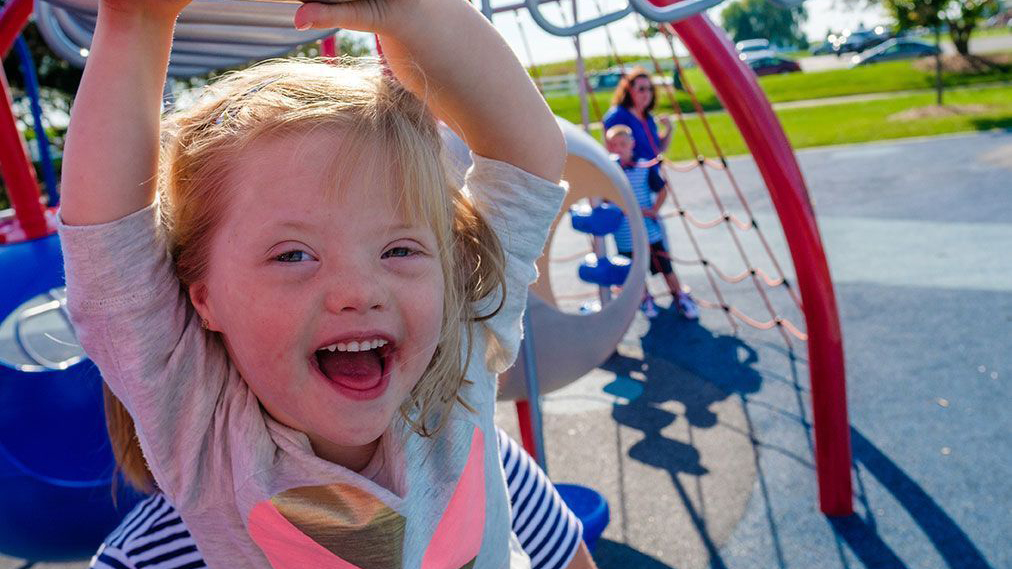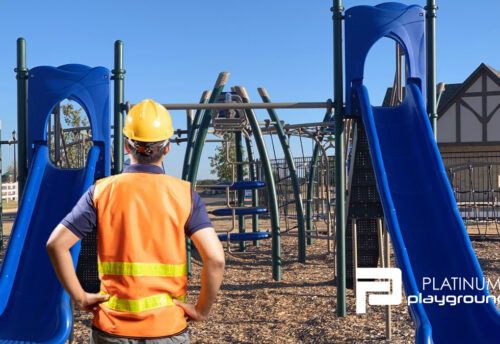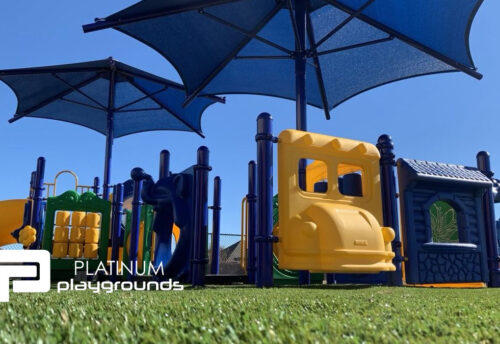Ensuring Playground Safety: Tips, Regulations, and Best Practices for Peace of Mind
If you’re managing a playground or recreation area, playground safety – creating a safe environment where kids can let loose without risk – is your number one responsibility. And while playgrounds are meant to be a place of fun and imagination, keeping them safe requires a practical, proactive approach. This blog will cover essential playground safety tips, dive into key regulations, and discuss what to look for in safe playground equipment. Because the only “high risk” at a playground should be whether a kid’s climbing attempt reaches the highest slide!

Why Playground Safety is a Big Deal
Playgrounds are where imaginations soar, and physical limits are tested—making them prime locations for both laughter and, occasionally, the odd scrape. Safety isn’t about limiting fun; it’s about providing a space where fun can happen without unnecessary risk. With the right setup, regular inspections, and a few industry-approved practices, you can make a commercial playground as safe as possible without sacrificing a single ounce of fun.
In fact, ensuring a playground is safe isn’t just about the immediate space; it’s about peace of mind for parents, caregivers, and operators alike. So let’s dive into what goes into creating a safe playground.
Key Safety Regulations for Commercial Playgrounds
Understanding the Standards
Several standards and guidelines regulate playground safety. Here are the key ones to know:
- ASTM International Standards**: ASTM F1487 is the go-to standard for playground equipment in the United States. It addresses everything from structural integrity to surfacing, spacing, and equipment heights.
- CPSC Public Playground Safety Handbook**: The U.S. Consumer Product Safety Commission (CPSC) provides detailed recommendations for playground layout, surfacing, and equipment design.
- ADA Compliance**: The Americans with Disabilities Act mandates that public spaces, including playgrounds, be accessible to all children, including those with disabilities.
These standards are not just checkboxes but are built to create environments where kids can explore safely. Meeting them means you’re already a step ahead in maintaining a safe playground.
Playground Safety Features That Make a Difference
1. Safety Surfacing: Cushioning the Falls
We all know that kids don’t fall gently. Whether it’s from the top of a slide or mid-swing on the monkey bars, falls happen, and the playground surface is a critical factor in reducing injury risk.
- Types of Safe Surfacing: Rubber mats, synthetic turf, engineered wood fiber, and sand are the most common types. Avoid concrete or asphalt, which can make a playground look less like a play space and more like a professional wrestling ring.
- Depth Matters: If using loose-fill material, it should be at least 12 inches deep, particularly under climbing structures and slides, where falls are more likely.
- Maintenance Tip: Regularly check and replenish loose-fill materials like wood chips or sand to maintain the right depth.
Safety Surfacing is one of the most important features for playground safety. Learn more about “Choosing Safety Surfacing for Commercial Playgrounds“ here.
2. Appropriate Equipment Height
Commercial playground equipment comes with recommended height limits for good reason—limits help reduce the risk of serious injuries. Here are a few general rules to follow:
- Age-Appropriate Heights: Equipment heights should match the age group using the playground. For example, preschoolers should stick to equipment no taller than six feet, while older children can safely navigate up to eight or nine feet.
- Adequate Spacing: Make sure there’s enough space between pieces of equipment to prevent overcrowding, reducing the risk of collisions.
3. Barrier Rails and Guardrails
Guardrails and barrier rails are essential in preventing unintended falls from higher structures. Think of them as the unsung heroes of playground safety.
- Guardrails: Guardrails are required for elevated surfaces where falls could occur. They’re especially helpful on equipment with steps or raised platforms.
- Barrier Rails: These are typically needed for equipment with large open spaces (like the edge of a platform) where a child might slip through. They’re usually designed for kids under 5 to keep them contained in play structures.
Conducting Regular Playground Safety Inspections: Your First Line of Defense
Let’s face it, playgrounds get a lot of use, which is fantastic! But with that use comes wear and tear. Regular inspections are crucial for spotting potential hazards before they become serious. Here’s a basic checklist:
- Loose or Missing Fasteners: Check bolts, screws, and other connectors. If it’s loose, tighten it. If it’s missing, replace it!
- Sharp Edges: Look out for any sharp edges on metal, plastic, or wood components. If you find any, smooth them down or replace the part.
- Rotting or Splintered Wood: This one’s pretty straightforward—kids don’t like splinters (and neither do adults). Wood should be sturdy and free from rot or splinters.
- Rust and Corrosion: Metal equipment is prone to rust over time, which can compromise its structural integrity. Inspect all metal parts regularly, and apply rust prevention products as needed.
Playground Safety Inspection Schedule Tips
- Weekly Walkthrough: A quick weekly inspection can catch obvious hazards. This can be as simple as checking for loose parts and clearing any debris.
- Monthly Deep Inspection: Conduct a more thorough inspection monthly, examining all equipment, surfacing, and safety features.
- Seasonal Inspection: With each new season, consider a comprehensive inspection to account for the effects of weather, especially if your playground is in a climate that experiences extreme conditions.
Learn more about the “Importance of Regular Playground Inspections“.
Selecting Safe Playground Equipment: What to Look For
Choosing playground equipment can be fun, but it also requires a careful eye for safety. Here’s what to prioritize:
1. High-Quality Materials
Whether it’s metal, wood, or plastic, quality matters. High-grade materials don’t just look good; they hold up against weather, wear, and tear, reducing the need for repairs or replacements.
- Stainless Steel: Rust-resistant and durable, stainless steel is a great choice for equipment that’s built to last.
- Treated Wood: Wood that’s treated for weather resistance is a beautiful option, though it requires occasional maintenance.
- Heavy-Duty Plastic: Plastic components should be UV-resistant and free from chemicals that can degrade over time. Look for high-density polyethylene (HDPE) for an eco-friendly and safe choice.
2. Age-Appropriate Equipment
Not every piece of equipment is meant for every age group. Many playground injuries occur when younger kids attempt to use equipment meant for older ones (or vice versa). To prevent this, invest in age-appropriate sections:
- Toddlers (0-2 Years): Soft, low-to-the-ground equipment. Think small slides, gentle ramps, and sensory panels.
- Preschool (3-5 Years): Medium heights with protective rails, low climbers, and accessible slides.
- School Age (6-12 Years): Higher slides, climbing walls, and more challenging elements.
3. Playground Safety Features in Equipment Design
The design of playground equipment plays a big role in overall safety. Look for:
- Rounded Edges: No sharp corners here! Rounded edges minimize injury risk.
- Grippy Handles and Steps: Surfaces kids hold onto or step on should be slip-resistant.
- Sturdy Foundations: Equipment should be anchored securely in the ground.
In Case of Emergency: What to Do If an Accident Happens
Accidents happen, even on the safest playgrounds. Having an emergency plan in place is essential.
- First Aid Kit**: Keep a well-stocked first aid kit nearby, with bandages, antiseptics, and basic medical supplies.
- Contact Information**: Have clear signage with contact numbers for emergencies.
- Incident Report Log**: Record any injuries, no matter how minor, as part of a risk management strategy. This helps in refining safety protocols over time.
Playground Safety Is a Shared Responsibility
Playground safety doesn’t just rest on the equipment and surfacing. Parents, caregivers, and kids play a role too! While kids will be kids, caregivers can teach them how to use equipment properly, share space with others, and play respectfully.
Creating a culture of safe play encourages everyone to use equipment responsibly, respect safety rules, and even report hazards if they notice something amiss. It takes a community to keep a playground safe and fun.
Partner with Platinum Playgrounds for Safe and Stunning Play Spaces
At Platinum Playgrounds, we take playground safety seriously—and we’re here to make your life a little easier. Whether you’re selecting new equipment, installing safety surfacing, or setting up a maintenance routine, we’ve got you covered.
From initial design to long-term maintenance, we understand the ins and outs of keeping a playground both fun and safe. Ready to build a playground you’ll feel confident in? Contact us today to get started, and let us help you create a space where kids can play safely for years to come!


